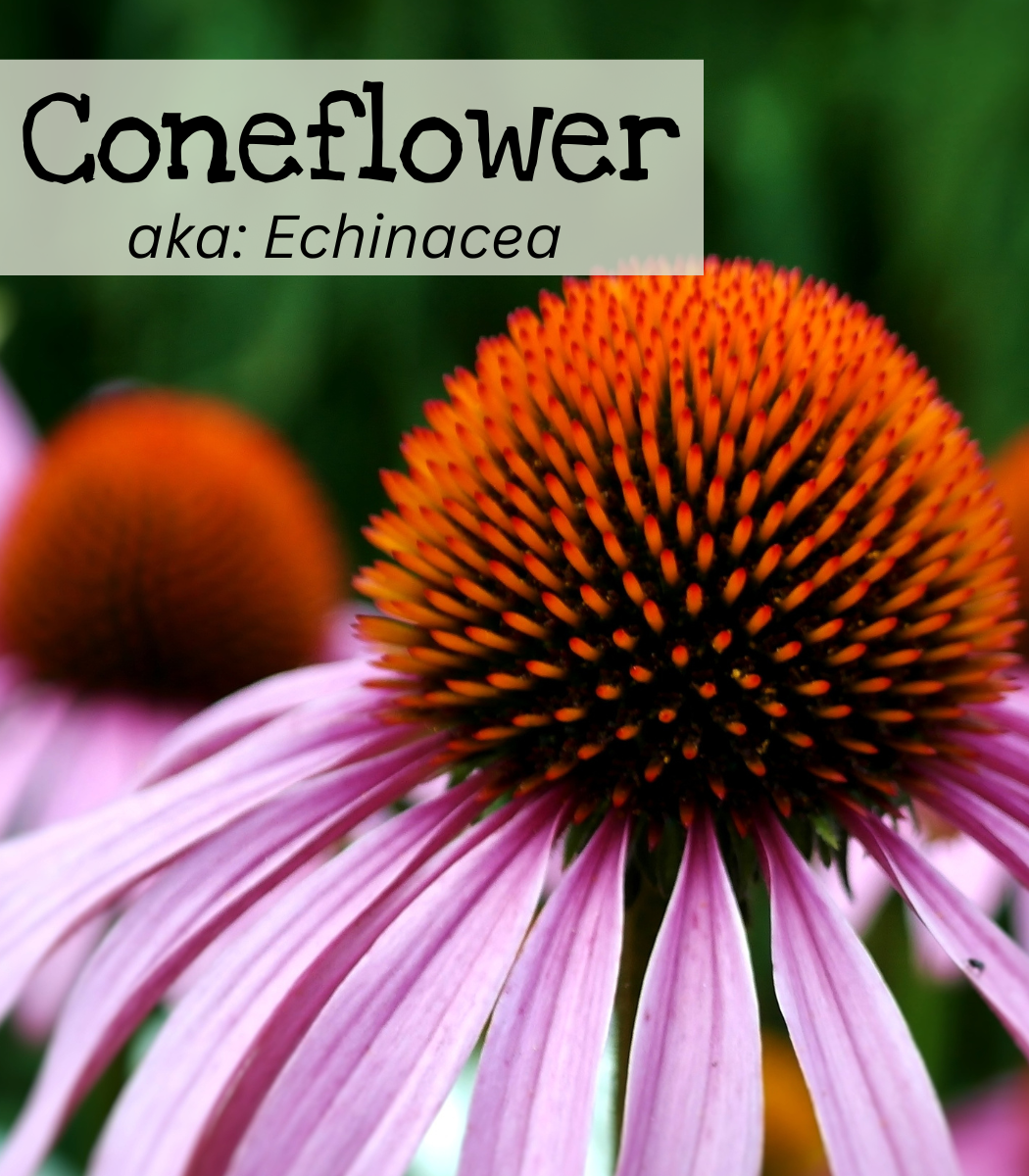
Coneflower (Echinacea)
Echinacea purpurea is native to the southern states, much of the Eastern U.S., and parts of the midwest U.S. Coneflower is a good nectar source for many insects and is can be used to make herbal tea.
|
Doubledecker; Green Twister; Paradiso Mix; Paradiso Super-Duper; Paradoxa; Purple |
|
Echinacea purpurea (all but Paradoxa) Paradoxa: Echinacea paradoxa Other varieties may have a different scientific name. |
|
Difficult to start from seed. Easy once established. |
|
Intermediate |
|
3 years if properly stored |
|
Perennial |
|
14-21 days |
|
None for Echinacea purpurea Cold Stratify for E. angustifolia, E. paradoxa, and E. tennesseensis |
|
1/4 inch |
|
Purple: 2-4′ |
|
Seeds need dark to germinate Full sun but can tolerate partial shade |
|
Second year |
|
February, March, and September Paradoxa: Only in January |
|
Yes |

Growing Tips



3 plants per 20” container

Native for most of the Eastern U.S. (including GA) and west of the Mississippi. (Including Colorado, Nebraska, Oklahoma, Texas)
When to Start
Start indoors: 8-12 weeks before the last frost date. (Beginning of February – Beginning of March for Jefferson, GA)
Varieties that need cold stratification: Start 16-24 weeks before the last frost date in spring. Or use the fall direct sow dates.
Transplant: After the danger of frost has passed and after hardening off. (May 1 for Jefferson, GA)
Fall Direct Sow: 2 weeks before the last frost. (End of Oct – Nov 1 for GA.)
How to Start
Coneflower is difficult to start from seed but easy to grow once established. It needs dark to germinate.
Should your variety of coneflower be either E. angustifolia, E. paradoxa, or E. tennesseensis you will need to cold stratify the seeds before sowing. Add 8-12 weeks (2-3 months) on top of the 8-12 weeks for starting indoors. These varieties need this time in the refrigerator before going under the grow lights. Altogether, from start to finish, it should take 16-24 weeks (4-6 months).
It probably would be more convenient to do a fall direct sow with these varieties. However, if you want to start them indoors, sow them according to the directions below and then place them in a plastic bag. You may need a piece of cardboard under the cells to give stability. I like to place the bag in a cardboard box that I can close up and then place the box in the refrigerator. The closed box is good for protection, and as the seeds need dark, it just adds another layer to keep them in the dark.
Check on them periodically and open the bag. You want them to remain moist, but not soggy. To wet and mold might grow, which could ruin the chances of germination. After the 8-12 weeks of cold stratification, remove them from the refrigerator and then place them under growlights.
Sow in seed cells to a depth of 1/4 inch 8-12 weeks before the last frost date. Once the seeds have germinated, place them under grow lights. Transplant after hardening off and all danger of frost has passed.
Or direct sow in fall. Sow into a full sun bed, to a depth of 1/4 inch, 2 weeks before the last frost (end of Oct-Nov 1 for GA). Thin or space to 18 inches.
Care
Coneflower prefers poorer soil for best flowering. You might have better luck if they are planted where they will get late afternoon shade to prevent the plants from burning.
They are drought-resistant. When the late summer blooms begin to look tired or ragged, cut the plant back by a third. This rejuvenates the plant, and often it produces a new display of beautiful blooms that last until frost. Booms Summer-Fall. Good for cut and dried flowers.
How to use Echinacea purpurea
Echinacea can be made into a tea. Use only E. angustifolia, E. purpurea, and E. pallida to make tea.
To make the tea, add 1 teaspoon of fresh flowers, leaves, or chopped roots or 10ml of dried plants to 2 cups of boiling water. Steep and then strain.
Seed Saving

Isolation Distance
Insect dependent for pollination. Isolate 1/2 mile to prevent cross-pollination.
Instuctions
Select healthy, robust plants free of any signs of disease or insect infestation for seeds. Seeds carry the traits of the parent plant. Choose plants that exhibit the traits you wish to preserve. Consider bloom size, color, and shape, as well as blooming time.
Allow the biggest and healthiest blooms to mature on the plant. Cover the seed head with a fine-mesh bag as soon as the flower petals shrivel and die. Use an elastic band to hold the bag in place. This prevents seeds from spilling onto the soil before harvest.
Clip the flower head from the main stem once the seeds are dry and dark. Separate plant debris from the seeds by removing the mesh bag and placing the flower head in a paper bag and shaking to loosen the seeds. Seeds settle to the bottom of the bag. Remove plant debris by hand.
Features
- Drought resistant
- Deer resistant
- Container friendly
- Attracts pollinators
- Poor soil tolerant
- Medicinal
- Good cut flowers
- Doubledecker: Heirloom. Perennial in zones 3-10. In the first year, you may have more single booms, but in the second year, they are double-tiered, and the plants can get 36-48 inches tall.
- Green Twister. Heirloom. The blooms are tipped in green with a purple center.
- Paradiso Mix: Heirloom. Multi-colored booms come in a range of reds, pinks, and whites.
- Paradiso Super-Duper: Heirloom. Perennial in zones 3-10. The blooms have rosy tones.
- Paradoxa: Heirloom. Needs 2-3 months of cold stratification. The blooms are golden-yellow.
- Purple: It has showy blooms on tall, sturdy stocks.

Even though E. purpurea isn’t listed as needed cold stratification, it is highly recommended. Cold stratify seeds for a month before starting indoors or direct sowing. This mimics nature’s stratification to help break the seeds’ hard outer coating. Some gardeners believe this creates more abundant blooms.
